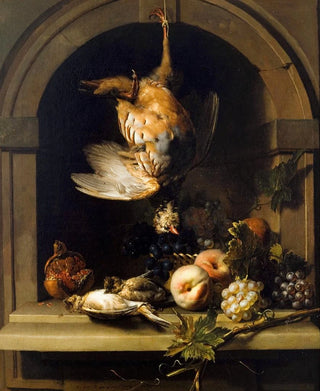Art print | Red partridge in a nest - Nicolas de Largillière


View from behind

Frame (optional)
In the fascinating world of 17th-century French painting, the art print "Red Partridge in a Nest" by Nicolas de Largillière stands out for its elegance and depth. This piece, which captures the beauty of a bird within a carefully crafted setting, invites viewers to immerse themselves in a world where nature and art harmoniously converge. Largillière, a master of portraiture and still life, succeeds here in transcending mere representation to offer a reflection on the fleeting beauty of life. The art print of this iconic work allows for a rediscovery of the very essence of Baroque art, while adding a touch of sophistication to any interior.
Style and uniqueness of the work
Nicolas de Largillière's style is characterized by meticulous attention to detail and masterful use of light. In "Red Partridge in a Nest," the bird is depicted with incredible precision, each feather rendered with a delicacy that highlights the artist's virtuosity. The composition is carefully balanced, with warm, rich colors that evoke an atmosphere of luxury and tranquility. The nest, adorned with delicate motifs, creates an intimate space where the observer can appreciate the beauty of nature while being aware of the artificiality of the scene. This tableau does not merely depict an animal; it also evokes deeper themes, such as the fragility of life and the relationship between man and nature.
The artist and his influence
Nicolas de Largillière, born in 1656, is an emblematic figure of French painting. Trained in Antwerp before establishing himself in Paris, he managed to establish himself as one of the most sought-after artists of his time, notably through his portraits of high society. His influence extends well beyond his era, inspiring many artists who followed in his footsteps. Largillière is often recognized for his ability to capture not only the physical appearance of his subjects but also their character and essence. In the realm of still life, he paved the way for a more expressive approach, where inanimate objects come to life and

Matte finish

View from behind

Frame (optional)
In the fascinating world of 17th-century French painting, the art print "Red Partridge in a Nest" by Nicolas de Largillière stands out for its elegance and depth. This piece, which captures the beauty of a bird within a carefully crafted setting, invites viewers to immerse themselves in a world where nature and art harmoniously converge. Largillière, a master of portraiture and still life, succeeds here in transcending mere representation to offer a reflection on the fleeting beauty of life. The art print of this iconic work allows for a rediscovery of the very essence of Baroque art, while adding a touch of sophistication to any interior.
Style and uniqueness of the work
Nicolas de Largillière's style is characterized by meticulous attention to detail and masterful use of light. In "Red Partridge in a Nest," the bird is depicted with incredible precision, each feather rendered with a delicacy that highlights the artist's virtuosity. The composition is carefully balanced, with warm, rich colors that evoke an atmosphere of luxury and tranquility. The nest, adorned with delicate motifs, creates an intimate space where the observer can appreciate the beauty of nature while being aware of the artificiality of the scene. This tableau does not merely depict an animal; it also evokes deeper themes, such as the fragility of life and the relationship between man and nature.
The artist and his influence
Nicolas de Largillière, born in 1656, is an emblematic figure of French painting. Trained in Antwerp before establishing himself in Paris, he managed to establish himself as one of the most sought-after artists of his time, notably through his portraits of high society. His influence extends well beyond his era, inspiring many artists who followed in his footsteps. Largillière is often recognized for his ability to capture not only the physical appearance of his subjects but also their character and essence. In the realm of still life, he paved the way for a more expressive approach, where inanimate objects come to life and






